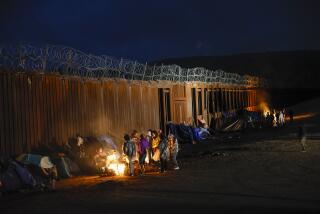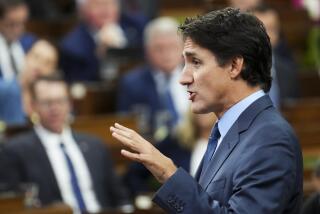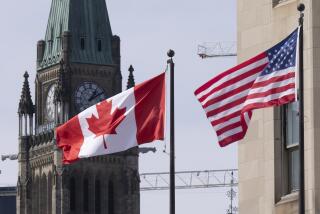With the U.S. looking to reopen, Canada seeks to prolong border closure
While parts of the United States rush to open restaurants, stores and public places, Canada — fearful of the high coronavirus contamination rates to the south — is rushing to keep the 5,525-mile border closed for nearly six more weeks.
Under a likely agreement between the two countries, Canada and the U.S. will continue to permit a portion of the trade that ordinarily accounts for more than $1 million a minute and supports nearly 1.2 million jobs in California. But since border restrictions were put in place, the traffic that in normal times accounts for 200,000 border crossings a day has ground to a virtual halt; 24 of the top 25 border gateways to Canada, for example, had no wait times for automobiles Wednesday.
Canada, which for more than a dozen years has been California’s second-largest outside market, accounted for more than $16.6 billion in exports in 2019. At the same time, according to the California Chamber of Commerce, the state imported $26.8 billion from Canada last year.
The U.S. and Canada began their border restrictions nearly eight weeks ago and then extended them until next week. But concerns about American rates of COVID-19 cases prompted Ottawa’s desire to keep the frontier closed until June 21.
“As we control our domestic situation,” Prime Minister Justin Trudeau said Wednesday, “we are vulnerable to international travelers.”
Though President Trump is eager to restore commercial activity, Washington is not likely to balk at the Canadian effort to extend the border restrictions.
The Trudeau government is concerned that virus cells in states bordering Canada, especially Washington, Michigan and New York, pose a danger to its citizens.
Indeed, there are fewer coronavirus cases in the entire province of Ontario, Canada’s most populous, than in Detroit, which is linked culturally and economically with Windsor, Ontario, its sister city across the 7,500-foot-long Ambassador Bridge and the 5,100-foot-long Detroit-Windsor Tunnel. Ordinarily the two cities share cultural events, a joint fireworks display around the time of Independence Day and Canada’s July 1 national day, and family visits. Last weekend, Windsor residents with relatives across the Detroit River went to the waterfront to wave to relatives across the border.
Windsor and Detroit share an integrated economy and community, connected by the Ford Windsor Engine Plant on the Ontario side and visits to the Somerset Collection mall in Troy on the Michigan side. Ontario nurses now are assisting coronavirus patients on the Michigan side.
“This is part of our history and our DNA,” Brian Masse, a member of the left-leaning New Democratic Party who represents the Windsor area in Parliament, said in an interview. “But it doesn’t help for us to be further exposed. Border Canadian communities have higher rates of infection than other places in Canada. There is amazing, hard nursing work going on in Detroit, but we can’t help our friends in America if we get infected at the rates you are getting infected.”
Three-quarters of Canadian exports go to the United States, while about a fifth of American exports are to Canada. Nearly 1.8 million people visit California from Canada, spending nearly $2 billion annually.
Trudeau said Wednesday he was “looking at stronger measures to make sure that we’re following up appropriately with people who come over,” adding that his priority was in “preventing transmission from outside of Canada into Canada once we have controlled the spread within Canada,” and explaining that he wanted to ensure “that we don’t fall back into a second wave.”
Canada’s eagerness to prevent a flood of Americans across the border comes in the context of increasing distaste for the Trump presidency and wonder at, if not contempt for, the American response to the virus threat.
“Any hope of economic recovery in Canada from the novel coronavirus pandemic hinges on the American economy recovering first,” John Ibbitson wrote this week in the Globe and Mail newspaper. “This is the worst possible news. For the United States is self-immolating.”
That view, widely held, feeds into a latent resentment in Canadian culture of the American giant at its doorstep.
“People tend to forget that historically the relationship has been very tense,” said Soren I. Fanning, a historian at Robert Morris University in Moon Township, Pa. “The Canadian experience is like living above a relatively good-natured neighbor who has a tendency to throw wild parties and occasionally go on a bender. The entire Trump presidency has been like a bender in Canada, where people are grimacing, closing the windows and waiting for the hangover to go away.”
Among the looming casualties of the most recent move to extend border restrictions: tourism in Montreal, Toronto and Vancouver, ordinarily strong in June; and fishing expeditions, affecting American outdoor enthusiasts as well as commercial outfitters, in Quebec, Ontario and British Columbia that usually serve waves of Americans in May and June. Even if the border were opened, strict Canadian 14-day quarantine requirements — with few exemptions beyond truck drivers (and fines of up to $532,050) — render tourism unrealistic.
Even business leaders in Canada express caution.
“Any reopening of the border to nonessential travel should be done cautiously and only when public health authorities deem it safe to do so,” said Goldy Hyder, president of the Business Council of Canada. “Given the size and importance of the U.S.-Canada trade relationship, it is critical that trade remain uninterrupted to support the eventual economic recovery. At the same time, the health and safety of people on both sides of the border must continue to be our top priority.”
Tom Creary, managing director of WestbridgeOne Consulting of Montreal and founder of the Quebec chapter of the American Chamber of Commerce in Canada, said governmental efforts to keep commerce flowing have substantial hidden costs.
“I’ve got clients who are shipping across the border and there have been no problems,” said Creary, who nonetheless is frustrated that executives of a Montreal company seeking to sell a software system for call-center operators in the U.S. have been unable to meet with potential customers. “These restrictions damage the building of ties across the border for business development. People have to have a degree of confidence in whom they deal with. It’s the personal relationships that matter.”
Trudeau said he would resist opening the border until he had assurance “that we have the mechanisms and the materials in place to deal with any further spreads or spikes in COVID-19.”
Moreover, the virus has strained Canada’s ability to regulate migration across the border, according to Geoffrey Hale, a political scientist at the University of Lethbridge in Alberta, a province that shares historic pioneer roots with the American Upper Midwest and that did $77.7 billion in trade across the border in 2018, making the U.S. by far Alberta’s largest trading partner.
“Right now the approach to phased reopening requires a capacity to move in a very measured fashion with the capacity to tighten up domestically,” Hale said. “There are significant concerns in the major borderlands regions. And we are not in a public health position to manage long volumes of cross border traffic at the major border crossings.”
More to Read
Inside the business of entertainment
The Wide Shot brings you news, analysis and insights on everything from streaming wars to production — and what it all means for the future.
You may occasionally receive promotional content from the Los Angeles Times.











